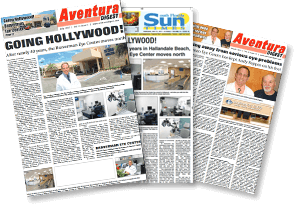Near-Far Multifocal PresbyLasik, Bifocal Lasik, Progressive Lasik and Multifocal Lasik
In the normal eye, images carried by light rays enter through the cornea, the crystal clear layer of tissue covering the eye. Passing through the lens near the center of the eye, the images are focused onto the retina at the rear of the eye. Vision occurs when these focused images are sent from the retina to the brain and are interpreted.
Presbyopia is an inevitable side effect of aging. Its time of onset varies but usually occurs between the ages of 40 to 45 when individuals begin to lose their ability to see objects close up, with or without glasses. This occurs when the lens, the clear focusing portion of the eye, thickens and gradually becomes resistant to bending or focusing. This is not, as many people fear, a serious deterioration of the eye. It is simply part of the normal aging process.
Near Vision Multifocal PresbyLasik, Bifocal Lasik, Progressive Lasik and Multifocal Lasik combines the correction of myopia (nearsightedness) with or without astigmatism OR hyperopia (farsightedness) with or without astigmatism with the correction of reading or near vision compromised by presbyopia. Since two excimer laser treatments are performed on each eye during the surgery, it is considered an off-label treatment.
What Happens During the Procedure?
Near Vision Multifocal PresbyLasik, Bifocal Lasik, Progressive Lasik and Multifocal Lasik begins with the application of numbing (anesthetic) eye drops. Once the surgeon is certain the eye is numb, the eyelids are kept open with a small instrument to prevent blinking. While the eye is numb, the surgeon creates a flap of very precise thickness. This disk, or corneal flap, is gently folded aside. The excimer laser treatments are performed on the central cornea. The hinged corneal flap is replaced into its pre-surgical position. No sutures are used. The surface of the eye is dried with oxygen and flushed with antibiotic drops. The entire procedure is over in 15-20 minutes. An eye shield is applied and is to be kept in place for less than 24 hours by the patient. In most instances bilateral, simultaneous surgery is performed.
Activities after Surgery
Patients are able to return to work, in most cases, less than 24 hours after the procedure. Eye medications should be continued during working hours, as instructed by the surgeon. Most activities may be resumed almost immediately. The face should not be placed under water for at least the first week following surgery, but showering with the eyes closed is acceptable. Care should be taken to avoid rubbing the eyes or trauma to the eyes. It is best to wear protective eye wear or an eye shield at all times. An eye shield should be placed over the eye at night for five days following the surgical procedure. Jogging, biking and aerobics are permitted. When only one eye is treated, it may be necessary to wear a contact lens in the un-treated eye or until the un-treated eye undergoes surgery.
Risks and Complications
Patients are able to return to work, in most cases, less than 24 hours after All eye surgeries carry certain risks. It is not possible to list all risks here. See our full PresbyLasik, Bifocal Lasik, Progressive Lasik and Multifocal Lasik Informed Consent for complications.
Surgical Alternatives to Near-Far Vision Multifocal PresbyLASIK, Bifocal Lasik, Progressive Lasik and Multifocal Lasik
Near Vision Multifocal Photorefractive Keratectomy (PRK): removes the superficial part of the center of the cornea to achieve corneal flattening for myopia and astigmatism and corneal steepening for hyperopia. This procedure does not weaken the cornea to the extent that LASIK does. Certain corneae are better treated with PRK. Your doctor will discuss this with you if applicable. Vision recovery is slower than LASIK. The major risk of PRK is scarring of the operated part of the cornea. Current PRK surgery is done using an anti-scarring agent, mitomycin, which has greatly reduced the incidence of scarring. This is an off-label use of the medication. PRK is potentially more painful in the first 24 hours than Z-LASIK (the all-laser LASIK procedure offered at Braverman Eye Center).
Lens Surgery: These procedures, which include refractive lens implants (ICLs) and refractive lens exchange, operate inside the eye (they are intraocular procedures). Risks of intraocular surgery include cataract formation, retinal detachment, hemorrhage and infection. They can correct more myopia or hyperopia than LASIK or other procedures. These procedures may be combined with LASIK in certain circumstances. Intraocular lenses are available in accommodative, multi-focal or monovision lens options.
Limitations of Surgery
It is important to understand the limits of refractive surgery. Individual cornea respond differently to surgery, and each individual has a unique healing process. These factors make exact predictions of surgical results or the promise of perfect vision without corrective lenses or contact lenses after refractive surgery impossible.
Learn More about Your Options
For more information about Near Vision Multifocal PresbyLasik, Bifocal Lasik, Progressive Lasik and Multifocal Lasik or the alternatives, please contact leading Miami/Ft. Lauderdale, Florida LASIK and cataract surgeon Dr. Stanley Braverman.



